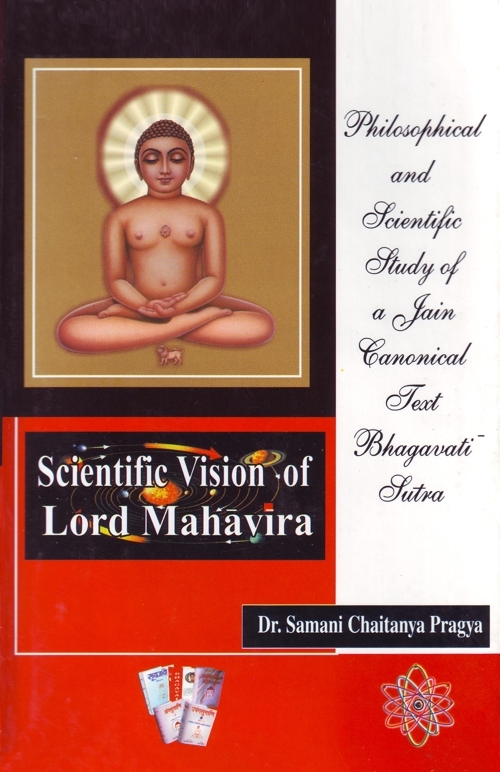Philosophers and sages, right from the Vedic period, have been in search of the fundamental elements constituting of the world of our experience. Diving deep into the self and the world they have arrived at various conclusions. According to the Nyaya[108]-Vaisheshika[109] philosophy, there are nine entities in the world, viz. space, direction, time, soul, mind, earth, water, air, and fire. The Samkhya-Yoga philosophy posits two basic elements named 'Prakṛti' and 'Purusa'.[110] The world is a manifestation of the former one. The Vedanta philosophy regards only one element i.e. Brahma (the supreme principle or God).[111] The whole world is coming out of the one.
In the same vein the Jain philosophy regards five extensive entities which constitute the fabric of the universe.[112] These entities are—the medium of motion, the medium of rest, space, matter and consciousness (soul or self).
As a matter of fact the Jain philosophy is dualistic as it accepts two fundamental principles i.e. soul and non-soul.[113] Of the five extended substances the four are the elaboration of latter one. The dualism in the form of soul and matter is found in all other dualistic philosophies of India but the concept of the medium of motion and the medium of rest is found only in Jain Philosophy. They are unique postulates in themselves.
Moreover, the word 'Dravya' is available in Vaisheshika philosophy. But the word 'Astikāya'[ ***] is not found in any other philosophy. It is a technical word of Jain philosophy. It denotes to a homogeneous extended reality. The five realities mentioned above in Jain philosophy come under the category of Astikāya. All have eternal independent existence. They are made up of innumerable or infinite units just as matter is made up of small atoms. But the atoms of the last four substances cannot be detached or detected. They are always connected and therefore called pradeśa. In the medium of motion and the medium of rest the number of the pradeśas is innumerable, while in space, matter and soul is infinite.[114] According to Acharya Mahapragya, the doctrine of six substances in which time is added to the five extended realities is a later development. This can be surmised from following two contexts in the Bh.S. The heretical teachers like Kalodāyi started discussion that Śrmana Jñātaputra (Lord Mahavir) propounded five Astikāyas.According of among the five substances, the soul is only a sentient entity while other are insentient. Moreover, of the five extended substances matter is corporeal, whereas the other four are non-corporeal. The non-corporeal is devoid of physical qualities i.e. colour, smell, taste and touch. The corporeal, on the other hand, possesses all the qualities.[115]
The Astikāyas and their properties are as follows. Here only a general description of them has been presented through a table. In the subsequent chapters each has been discussed in details with scientific assessment.
| Table No. 2 Five Extended Substances and their Properties | ||||||
| Substance | Conscious/ Non-conscious | Corporeal/ Non-corporeal | Number units | Function | One Infinite | With respect to space |
Dharmāstikāya | Non-conscious | Non-corporeal | Innumerable | Indifferent auxiliary condition of motion | Single substance | Coextensive with cosmic space |
Adharmāstikāya | - do - | - do - | - do - | Indifferent auxiliary condition of rest | - do - | - do - |
Ākāśāstikāya | - do - | - do - | Infinite | Receptacle | - do - | Coextensive with cosmic & t rans- cosmic space |
Pudgalāstikāya | - do - | Corporeal | - do - | Integration | Infinite number of substances | Coextensive with cosmic space |
Jīvāstikāya | Conscious | Non-corporeal | With respect to single soul it is innum- erable; with respect to Jivāstikāya (all the souls) it is infinite | Sentience | - do - | - do - |
present and future. 2. Individual unit. Kaya means heap.
(i) Sāṁkhyakārikā; 36—mulaprakṛtiravikṛtir mahadādyaḥ prakṛtivikṛtayaḥ sapta / ṣoḍaśakastu vikāro na prakṛtir na vikṛtiḥ purūṣaḥ
Taittiriya Upaniṣada, Bhṛguvalli Prakaraṇa; 3/1/1—tam hovaca, yato vā imāni bhūtāni jāyante, yena jātāni, jīvanti, yat prayantyabhi samvisanti tad
vijijñāsasva, tad brahmeti,(i) Bh.S; 13/4/55; (ii) Uttarā; 28/7—dhammo adhammo āgāsaṃ kālo puggalajantavo esā logo tti paṇṇatto, jiṇehiṃ varadaṅsihiṃ
(i) Bh.S; 25/2/9—jīvadavvā ya, ajīvadavvā ya. (ii) Ibid., 36/2—jīvā ceva ajīvā ya, esā loe viyāhie ajīvadesamāgāse, aloe se viyāhie
 Dr. Samani Chaitanya Pragya
Dr. Samani Chaitanya Pragya

